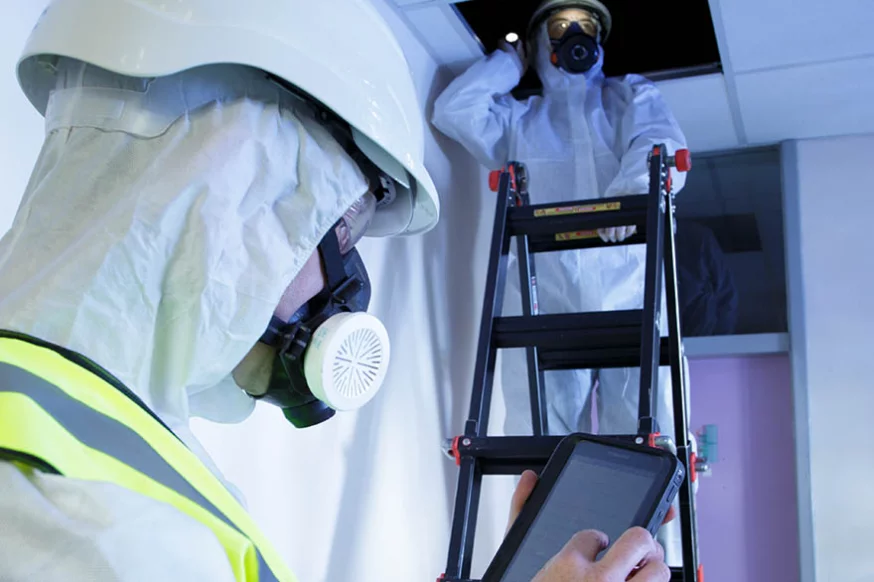The Best Guide To Asbestos Removal
Table of ContentsAll about Asbestos RemovalAll about Asbestos RemovalSome Known Factual Statements About Asbestos Removal What Does Asbestos Removal Do?
Ventilation requirements specified in paragraphs 1 and 2 of subsection 12( 3) assistance to ensure that workers in other parts of the work environment are not exposed to asbestos. In addition, the Regulation also requires a polyethylene enclosure if the work location is not enclosed by walls and the operation is being brought on indoors.

The work area need to be separated from the rest of the work environment by walls, barriers, fencing, or other methods that appropriate in the situations - Asbestos Removal. Indoor Type 3 operations mentioned in subsection 18( 4) require the usage of a polyethylene or other ideal enclosure unless walls enclose the workspace. Unfavorable air pressure should be maintained inside the enclosure unless the structure will be demolished and will just be gotten in by employees included in the elimination or by demolition workers.
Examination and maintenance of the unfavorable air system, routine measurement of the unfavorable air pressure, and routine examinations of the work area (particularly the enclosure, barriers and decontamination center) are regulatory requirements that help to minimize air-borne asbestos fibre concentrations inside the enclosure. All Type 3 operations require separation in between the workspace and the rest of the work environment utilizing walls, barricades, fencing or other suitable ways.
The 6-Second Trick For Asbestos Removal
When it comes to a multilevel workspace in an outdoor Type 3 operation explained in paragraphs 1, 2, 3, and 4 of subsection 12( 4 ), such as an elimination on the side of a building that needs making use of scaffolding, the various work levels should be separated so that dust and waste will not fall easily from one level to another.
If the work is done outdoors or if it is carried out in a structure that will be demolished and will only be gotten in by the workers doing the asbestos removal or by workers included in the demolition, then negative atmospheric pressure does not need to be kept inside the enclosure.
The Guideline also prescribes hygiene practices and treatments to safeguard workers, consisting of washing or shower facilities, decontamination of personal protective clothes and devices, the prohibition of consuming, drinking, chewing and cigarette smoking, and the strict separation of tidy and infected clothing and devices. Facilities for cleaning the hands and face should be provided for employees and the workers need to utilize them when leaving the work location.
Facilities for cleaning the face and hands need to be provided and every employee must utilize these facilities as they leave the work area. Employees who are performing Type 3 operations described in paragraphs 1, 2, 3, 4 and 6 of subsection 12( 4) should travel through a decontamination center as they leave the work location (Asbestos Removal).
Indicators on Asbestos Removal You Need To Know
If the work is done outdoors see this site the decontamination center must be set up as close as practicable to the work area. If the work is done indoors the decontamination facility should be located so that the employees must go through it to get in and leave the work area. Nevertheless, in some situations it might be essential for the company to use the arrangements of section 23 to differ the techniques and procedures set out in the Regulation to set up a remote decontamination facility.

It is also recommended that non-powered respirators be thoroughly washed and, in the case of a filter respirator, the filter cartridges soaked in the shower and disposed of on the dirty side of the shower. The employee then exits the shower from the clean side, with the respirator, site link and dons street clothing or a brand-new set of coveralls that are stored in the clean room.
Facilities for washing the hands and face must be supplied and every worker must utilize these centers when leaving the workspace. The individual protective clothes and equipment needed by the Guideline consists of respirators, to control the exposure of workers in the workspace, and protective clothes, to secure workers from secondary exposures and to avoid employees from transferring asbestos from the workspace.
The Main Principles Of Asbestos Removal
To learn more on respirators see Chapter 12 (Asbestos Removal). Respirators authorized by the National Institute for Occupational Safety and Health (NIOSH) might be used in Type 1 operations if the worker requests them and are needed for Type 2 and Type 3 operations. Table 2 of the Regulation (see Chapter 12) summarizes the respirator requirements for Type 1, Type 2, and Type 3 operations.
The requirements for protective clothing are set out in paragraph 12 of area 15 of the Regulation. It should: be made of material that does not retain or permit the penetration of asbestos fibers, include ideal footwear and a head covering, and include a complete body covering that fits comfortably at the wrists, ankles and neck.
They can be quickly torn, nevertheless, and must be repaired or changed when this happens. The option of appropriate footwear is dependent on the kind of work. High leading rubber boots are ideal for wet elimination work, and are readily available as safety footwear. Traditional security boots or safety shoes may be better suited for other types visit this page of work.